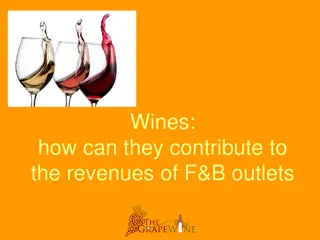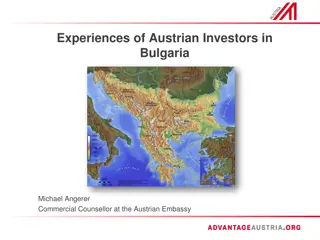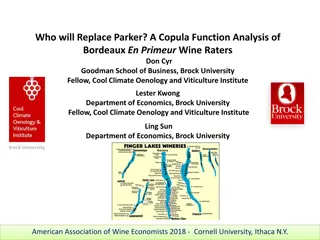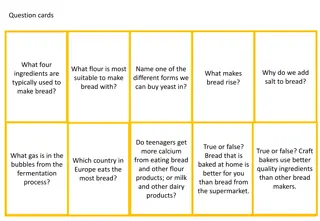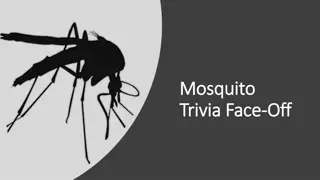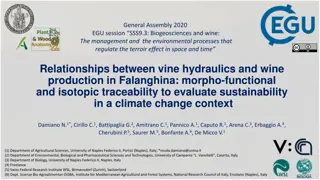Exploring Austrian Wine: Trivia and Facts
Discover fascinating trivia and interesting facts about Austrian wine, from the origins of wine cultivation in the country to its main regions and unique wine taverns. Learn about Austria's rich wine culture, notable vineyards, and historical events that have shaped the country's winemaking heritage.
Download Presentation

Please find below an Image/Link to download the presentation.
The content on the website is provided AS IS for your information and personal use only. It may not be sold, licensed, or shared on other websites without obtaining consent from the author. Download presentation by click this link. If you encounter any issues during the download, it is possible that the publisher has removed the file from their server.
E N D
Presentation Transcript
"Wien" is? a. - The German word for wine. b. - The local name for the Austian capital of Vienna. c. - A wine growing region. d. - Both b. and c.
A "Heuriger" or "Buschenschank" is? a. - The Austrian term for a roasted pork hock. b. - The term for someone who drinks too much and becomes rowdy. c. - A wine made from the free run grape juice before the grape must is pressed. d. - An Austrian wine tavern, first established by Emperor Josef II in 1784, at which producers may sell their wine.
Austria was settled by various Celtic peoples between 1200 500 BCE. What was the approximate date of the first record of cultivated vines in the country? a. - 600 BCE. b. - 500 CE. c. - 900 BCE. d. - 900 CE.
Austria currently has approximately 45,000 hectares planted to vine. At its peak in the 16thcentury, approximately how many hectares were planted to vine? a. - 20,000. b. - 50,000. c. - 100,000. d. - 150,000.
This appellation, centered around the town of Langenlois, produces complex Riesling and Gr ner--especially from the famous steeply terraced Heiligenstein vineyard. a. - Thermenregion. b. - Kamptal. c. - Kremstal. d. - Carnuntum.
Austria's four main wine regions are? a. - Kamptal, Kremstal, Wachau, and Wagram. b. - Burgenland, Mittelburgenland, Sudburgenland, and Steiermark. c. - Burgenland, Nieder sterreich, Steiermark, and Vienna. d. - Burgenland, Mittelburgenland, Sudburgenland, and Thermenregion.
This region is Austrias largest federal state, is home to over 28,000 hectares of vines, and is responsible for over half of Austria s total wine production. Which region is it? a. - Burgenland. b. - Nieder sterreich. c. - Steiermarck. d. - Vienna.
In 1681, citizens of this city bought their independence by paying 60,000 golden coins and 500 barrels of their widely coveted sweet wine to the Habsburg family. Is it? a. - Krems. b. - Kamp. c. - Stein. d. - Rust.
A "Ried" is a what? a. - The Austrian term for a vineyard site. b. - An Austrian Red wine. c. - The most prized category of wines from the Wachau region. d. - The name given to inhabitants of the winemaking town Riedfriemark.
DAC, the acronym referring to the regulated appellations of origin in Austria, stands for: a. - Districtus Austriae Controllatus. b. - Distrikt Austrig Controller. c. - Distrikt Austerrike Controllera. d. - None of the above.
A "Rotgipfler" is a? a. - A red grape - a cross between Roter Veltliner and Savagnin--from the Thermenregion. b. - A white grape - a cross between Traminer and Roter Veltliner. c. - A creature found in the "Fantastic Beasts and Where to Find Them" guidebook. d. - The local nickname for the prominent red wine loving wine critic Robert Parker.
"Federspiel" is a term that refers to? a. - The middle of the three categories of dry whites for which alcohol and minimum must weight are stipulated for Austria s Wachau region. b. - A term meaning feather play, referring to the practice of falconry. c. - Both a. and b. d. - Neither a. nor b.
Riesling thrives in the primary rock-based soils of the Kremstal, Kamptal, and the Wachau. Approximately how many hectares are planted to Riesling in Austria? a. - 2,000. b. - 15,000. c. - 20,000. d. - 5,000.
This red variety is the same variety as Hungarys K kfrankos and Germany s Lemberger and produces wines full of wild berry and forest notes. a. - Blauer Burgunder b. - Blauer Wildbacher c. - Sankt Laurent d. - Blaufr nkisch
This red grape variety takes its name from a saint believed to have been born on August 10th, when it begins to ripen, and produces wines that are similar to Pinot noir. a. - St. R sler. b. - St. Laurent. c. - St. Burgunder. d. - St. Dominic.
Roughly 6,500 hectares of vineyards are planted to this variety, which is a crossing of Blaufr nkisch and St. Laurent, making it Austria s most planted red varietal. a. - St. Fr nkisch. b. - Blauer Laurenter. c. - Blauer Portugieser. d. - Zweigelt.
Klosterneuburger Mostwage" (or KMW) refers to? a. - Wines made from the vineyards of the Monastery Klosterneuburg. b. - A unit of measurement for grape ripeness specific to Austria. c. - The degree earned by graduates of the viticultural and oenological school in Klosterneuburg. d. - The appellation control system of Austria, similar to the AOP/AOC system in France.
Winemaking within the walls of this city of the same name predated the Romans. Today, this region is known for its white wine field blends, known as Gemischter Satz. Is it? a. - Burgenland. b. - Nieder sterreich. c. - Steiermark. d. - Vienna.
This term refers to wines made from the ripest grapes from the best sites of the Wachau and is derived from the emerald-colored lizards frequently seen basking in the sun. a. - Smaragd. b. - Steinfeder. c. - Smaragad. d. - Sm rrebr d.
This region is known for a 36-kilometer-long shallow lake, which allows the region to produce sweet wines from botrytized grapes. This region also makes red wine of note. a. - Burgenland. b. - Nieder sterreich. c. - Steiermark. d. - Vienna.






